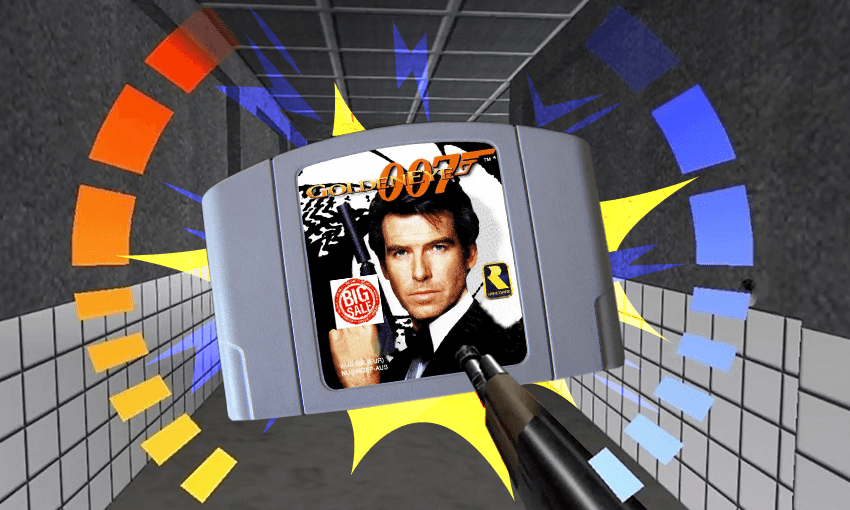Summer read: It was expected to be another mediocre video game based on a movie. Instead it changed gaming forever. 25 years on, Sam Brooks remembers GoldenEye 007.
First published August 25, 2022.
If you grew up in the 90s and had access to a Nintendo 64, you almost certainly played GoldenEye. If you played it enough, the phrase “Licence to Kill, slappers, Oddjob” is probably etched somewhere deep in your brain like a wake-up phrase for a sleeper agent.
GoldenEye (officially GoldenEye 007), based on the 1995 James Bond film of the same name, is one of the most enduring games of the past 25 years. The first-person shooter with a robust multiplayer mode was an immediate critical hit, and went on to sell over eight million copies across the world, making the the highest-selling non-Mario game on the Nintendo 64.
Looking back, it’s important to remember that GoldenEye was released into a world that had almost zero expectations for it. The only thing more reviled than video games movies are movie video games; the stigma around licensed games still exists, but in the mid-90s it was pretty much assumed that any game based on a movie was going to be a terrible cash grab. To make things even less promising, multiple delays meant it ended up coming out so late that it was essentially promo for the next Bond film, Tomorrow Never Dies.
At the time the first-person shooter was a genre that had yet to be a proven console success. It’s hard to imagine now, when first-person shooters are available on everything that can manage a video game, including your phone, but in 1997 they were pretty much a PC-only affair. This meant that you had to have a machine capable of running a game that demanded a lot of CPU, RAM and other acronyms.
GoldenEye changed that – you could play it on any old Nintendo 64, because that’s how console games work. Not only that, but it handled beautifully (although compared to modern games, it handles closer to a rhinoceros than not). Without GoldenEye, we wouldn’t have Halo, without which we wouldn’t have Call of Duty, without which we probably wouldn’t have Fortnite, for better or worse.
GoldenEye had an uncommon attention to detail that made it a joy to play, and pioneered mechanics that are now standard in not just FPS shooters but video games in general. Details like a gun playing not just one stock sound when firing, but one of nine random sounds, are the kind of thing that made GoldenEye stand out. It was a game made with care, not just to cash in.
But the main thrill of GoldenEye didn’t come from its single player mode. The game’s campaign, which loosely retells one of the best, campest Bond films, is aggressively fine – although it has to be said that the level design, invoking real-life architecture, with rooms and spaces that served no in-game function but built a vibe, was years ahead of its time. Instead, the real thrill came from multiplayer mode.
That’s remarkable when you consider that multiplayer was added basically as an afterthought, just six months before release. It didn’t even require any additional assets – all the levels and all the models are in the campaign. It was included merely as a nice-to-have. Nobody could have predicted that it would become the game’s main draw.
Looking back, the multiplayer mode seems pretty barebones. The different kinds of matches, with rules based on Bond film titles – You Only Live Twice gives each player two lives, The Man With the Golden Gun adds the titular weapon into the mix, The Living Daylights is a capture the flag type situation – are pretty standard now. And the characters are pretty indistinct, with the only exception being Oddjob, due to his short stature – it gave him such an advantage the developers admitted that playing as the henchman was tantamount to cheating.
What really made the game special, in the same way as the N64’s similarly successful Mario Kart, was that it brought people together in the same space to play against each other in a way that was relatively accessible. To have a Nintendo 64 and four controllers definitely required a certain level of wealth, but it was still a lot easier than getting four PCs in the same room. It was a rush of thrill that you can’t get from Fortnite – no online experience can replicate seeing the whites of someone’s eyes as you knock them down with a slapper (literally a mannequin hand), killing them in the press of a button, knowing they’ll come back next round for revenge.
GoldenEye doesn’t just represent nostalgia for a kind of gaming that put people in the same room, gathered around one screen, rather than scattered across the globe, sitting behind many screens. It also represents nostalgia for an entire gaming era, one before lootboxes, live service and constant patches and updates to a game. When you bought GoldenEye, you got the whole game, all it would ever be.
That’s what made GoldenEye special. It wasn’t necessarily the game, as great as it is, but the memories you forged with it, with your mates, match after match.

